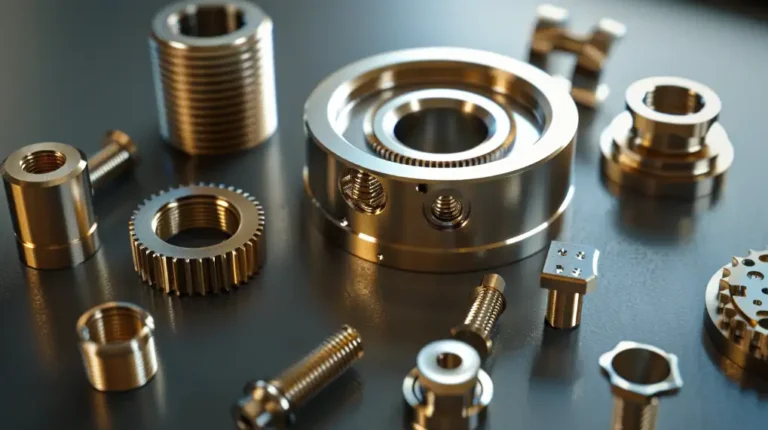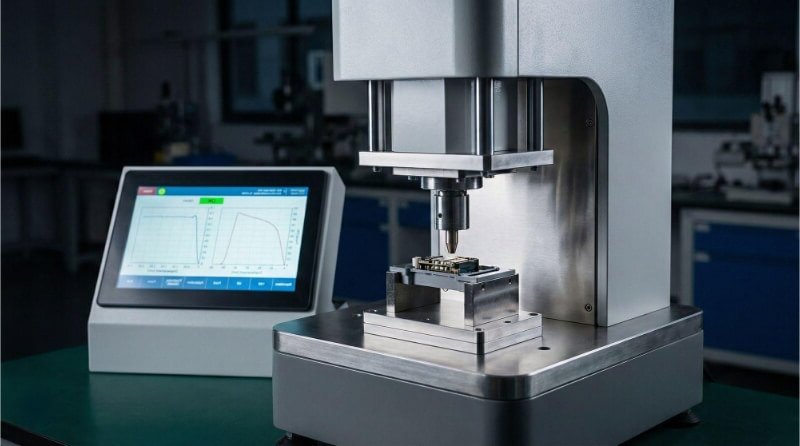Czy Twój projekt koncentruje się na precyzji i wydajności? Prawdopodobnie zastanawiasz się, czy wybrać frezowanie CNC czy toczenie. Obie metody obróbki są doskonałe, ale każda z nich ma swoje mocne strony. Wybór odpowiedniej z nich pozwala zaoszczędzić czas i pieniądze oraz poprawić jakość produktu.
Frezowanie CNC jest idealne do części o złożonych kształtach i cechach, takich jak otwory, szczeliny lub skomplikowane kontury. Wykorzystuje ono obracające się narzędzie do cięcia przedmiotu obrabianego pod różnymi kątami. Toczenie CNC jest najlepsze dla okrągłych, cylindrycznych części. Przedmiot obrabiany obraca się, podczas gdy narzędzie tnące pozostaje nieruchome. Oba procesy zapewniają precyzję, ale różnią się sposobem usuwania materiału.
Jeśli chcesz dowiedzieć się, kiedy stosować poszczególne procesy, czytaj dalej. Pomoże ci to określić najlepszą metodę dla następnego projektu.
Co to jest frezowanie CNC?
Frezowanie CNC to precyzyjny proces obróbki, który usuwa materiał z przedmiotu obrabianego. Jest on kontrolowany przez program komputerowy, który kieruje ruchem narzędzia tnącego wzdłuż różnych osi. Pozwala to na wysoką dokładność i wszechstronność w produkcji.
Frezowanie CNC wykorzystuje frezy obrotowe do usuwania materiału z przedmiotu obrabianego. Przedmiot obrabiany pozostaje nieruchomy, podczas gdy narzędzie tnące porusza się wzdłuż różnych osi. Proces ten może tworzyć różne kształty, od prostych do złożonych, z wąskimi tolerancjami.
Kluczowe cechy frezowania CNC
- Precyzja: Frezowanie CNC zapewnia wysoką dokładność, dzięki czemu nadaje się do złożonych części.
- Elastyczność: Może pracować z różnymi materiałami, takimi jak metale, tworzywa sztuczne i kompozyty.
- Wiele osi: Frezarki CNC często działają w 3 do 5 osiach, zapewniając większą elastyczność w przypadku skomplikowanych projektów.
- Automatyzacja: Proces jest sterowany komputerowo, co minimalizuje błędy ludzkie i zwiększa powtarzalność.
Typowe zastosowania frezowania CNC
Frezowanie CNC jest wykorzystywane w różnych gałęziach przemysłu, w tym:
- Lotnictwo i kosmonautyka: Do części wymagających wysokiej precyzji i wytrzymałości.
- Motoryzacja: Produkcja złożonych komponentów silnika.
- Medyczny: Do tworzenia niestandardowych protez i implantów.
- Elektronika: Do produkcji obudów i obudowy dla urządzeń.
Plusy i minusy frezowania CNC
Plusy:
- Wysoka precyzja: Może osiągnąć bardzo wąskie tolerancje.
- Złożone kształty: Zdolny do produkcji skomplikowanych części z wysoką dokładnością.
- Wszechstronność: Może być używany z szeroką gamą materiałów.
Cons:

Czym jest toczenie CNC?
Toczenie CNC to kolejny popularny proces obróbki, w którym obrabiany przedmiot obraca się, podczas gdy narzędzie tnące pozostaje nieruchome. Proces ten jest idealny do tworzenia części o cylindrycznych lub kulistych kształtach i jest znany ze swojej wydajności i dokładności.
Toczenie CNC wykorzystuje obracający się przedmiot obrabiany i stacjonarne narzędzie tnące do usuwania materiału. Maszyna działa wzdłuż wielu osi, kształtując materiał w cylindryczne, stożkowe lub kuliste kształty. Sterowanie odbywa się za pomocą programu komputerowego, co zapewnia stałą precyzję podczas całego procesu.
Kluczowe cechy toczenia CNC
- Kształty cylindryczne: Toczenie CNC jest najczęściej stosowane w przypadku części o symetrii obrotowej, takich jak wały, rury i koła.
- Wydajność: Jest to bardzo wydajny proces, szczególnie w przypadku części wymagających masowej produkcji.
- Prostota: Proces ten jest często prostszy niż frezowanie CNC w przypadku okrągłych lub symetrycznych części.
- Automatyzacja: Podobnie jak frezowanie CNC, toczenie CNC jest sterowane komputerowo, co ogranicza błędy ludzkie i zwiększa powtarzalność.
Typowe zastosowania toczenia CNC
Toczenie CNC jest szeroko stosowane w różnych gałęziach przemysłu w przypadku części wymagających okrągłego kształtu, w tym:
- Motoryzacja: Do produkcji wałów, kół zębatych i elementów silnika.
- Lotnictwo i kosmonautyka: Do produkcji części takich jak łopatki turbin i inne elementy obrotowe.
- Medyczny: Do produkcji części takich jak implanty dentystyczne i narzędzia chirurgiczne.
- Ropa i gaz: Służy do tworzenia zaworów i złączek.
Plusy i minusy toczenia CNC
Plusy:
- Wydajność: Toczenie CNC jest szybsze niż inne procesy obróbki części cylindrycznych.
- Opłacalne: Jest to często bardziej przystępne cenowo rozwiązanie do masowej produkcji elementów cylindrycznych.
- Wysoka precyzja: Zapewnia doskonałą dokładność w przypadku części o symetrii kołowej lub obrotowej.
Cons:
- Ograniczenie do kształtów cylindrycznych: Toczenie CNC najlepiej nadaje się do części o symetrii obrotowej, więc nie jest idealne do skomplikowanych kształtów.
- Zużycie narzędzia: Podobnie jak w przypadku frezowania CNC, narzędzia tnące mogą się z czasem zużywać, zwiększając koszty konserwacji.
- Ograniczenia rozmiaru: Większe części mogą być trudniejsze lub niepraktyczne do obróbki za pomocą toczenia CNC.

Kluczowe różnice między frezowaniem i toczeniem CNC
Zrozumienie różnic między frezowaniem CNC a toczeniem jest niezbędne przy podejmowaniu decyzji o wyborze jednej z tych dwóch metod dla danego projektu. Oto zestawienie kluczowych czynników, które należy wziąć pod uwagę przy wyborze odpowiedniej metody dla swoich części.
Kompatybilność materiałowa
Zarówno frezowanie CNC, jak i toczenie mogą pracować z różnymi materiałami. Jednak każdy z nich wyróżnia się innymi materiałami. Toczenie CNC jest najlepsze dla metali takich jak stal, aluminium i mosiądz. Dobrze sprawdza się w przypadku części o cylindrycznych kształtach.
Frezowanie CNC nadaje się również do metali, ale jest bardziej wszechstronne. Może obsługiwać tworzywa sztuczne, kompozyty i materiały niemetaliczne. Frezowanie jest szczególnie przydatne, gdy część ma złożony kształt.
Złożoność geometrii części
Frezowanie CNC jest lepsze w przypadku części, które wymagają skomplikowanych kształtów, nieregularnych powierzchni lub wielu otworów. Może tworzyć skomplikowane projekty, które są idealne dla niestandardowych lub szczegółowych części.
Toczenie CNC najlepiej sprawdza się w przypadku części symetrycznych lub cylindrycznych. Należą do nich wały, koła zębate i koła pasowe. Podczas gdy toczenie oferuje wysoką precyzję, ma ograniczenia, jeśli chodzi o bardziej złożone projekty.
Ruch przedmiotu obrabianego
Podczas frezowania CNC obrabiany przedmiot pozostaje nieruchomy, podczas gdy narzędzie tnące obraca się w celu usunięcia materiału. Taka konfiguracja zapewnia większą elastyczność kształtowania i cięcia różnych części.
Toczenie CNC polega na obracaniu obrabianego przedmiotu, podczas gdy narzędzie tnące pozostaje nieruchome. Jest to idealne rozwiązanie do kształtowania części cylindrycznych, ale mniej odpowiednie do nieregularnych kształtów.
Narzędzia tnące
Frezowanie CNC wykorzystuje różne obrotowe narzędzia skrawające, takie jak frezy walcowo-czołowe, wiertła i frezy czołowe. Narzędzia te są dostępne w różnych kształtach i rozmiarach, umożliwiając tworzenie szerokiej gamy elementów, takich jak szczeliny, otwory i kontury.
Toczenie CNC wykorzystuje stałe narzędzie tnące, które porusza się po obracającym się przedmiocie obrabianym. Narzędzie zazwyczaj wykorzystuje płytki tokarskie lub wiertła, które są skuteczne w kształtowaniu form cylindrycznych.
Rodzaje części najlepiej nadających się do każdego procesu
Frezowanie CNC jest idealne dla części, które wymagają szczegółowych projektów, złożonych elementów lub niecylindrycznych kształtów. Jest powszechnie stosowane w przemyśle lotniczym, motoryzacyjnym, urządzeń medycznych i produkcji niestandardowej.
Toczenie CNC jest idealne do masowej produkcji symetrycznych, okrągłych części, takich jak wały, pierścienie i tuleje. Jest wysoce wydajne w przypadku produkcji wielkoseryjnej, gdzie precyzja i wykończenie powierzchni mają kluczowe znaczenie.

Wybór między frezowaniem CNC a toczeniem
Wybierz odpowiedni proces, dopasowując go do wymagań swojej części. Oto, kiedy każda metoda działa najlepiej:
Kiedy wybrać frezowanie CNC?
- Część ma złożone kontury 3D lub organiczne kształty
- Potrzebne są precyzyjne płaskie powierzchnie lub elementy kątowe
- Konstrukcja wymaga głębokich kieszeni, skomplikowanych szczelin lub podcięć
- Praca z twardymi materiałami (stal narzędziowa, tytan)
- Część ma wiele operacji obróbki na różnych powierzchniach
- Potrzebne są wąskie tolerancje dla elementów niecylindrycznych
- Prototypowanie Lub Produkcja małoseryjna Tam, gdzie liczy się elastyczność konfiguracji
Kiedy wybrać toczenie CNC?
- Część jest przede wszystkim cylindryczna lub obrotowo symetryczna.
- Wymagana jest doskonała koncentryczność lub okrągłość
- Konstrukcja charakteryzuje się stałymi średnicami wzdłuż osi
- Produkujesz duże ilości identycznych części
- Efektywność kosztowa ma kluczowe znaczenie w przypadku prostych geometrii
- Potrzebujesz szybkiej produkcji okrągłych części
Wnioski
Zarówno frezowanie CNC, jak i toczenie są precyzyjnymi procesami obróbki, ale nadają się do różnych projektów. Frezowanie CNC sprawdza się najlepiej w przypadku części o złożonych kształtach, szczegółowych cechach i nieobrotowych konstrukcjach. Toczenie CNC jest bardziej wydajne w przypadku produkcji części cylindrycznych lub symetrycznych obrotowo. Właściwy wybór zależy od złożoności części, materiału i wymagań produkcyjnych.
Gotowy do rozpoczęcia kolejnego projektu? Skontaktuj się z nami Skontaktuj się z nami już dziś, aby omówić swoje potrzeby w zakresie frezowania lub toczenia CNC i pozwól nam pomóc Ci ożywić Twoje projekty z precyzją i wydajnością.
Więcej zasobów:
Dokładność i tolerancje obróbki CNC – Źródło: 3ERP
Materiały do obróbki CNC – Źródło: Fiktiv
Hej, jestem Kevin Lee

Przez ostatnie 10 lat byłem zanurzony w różnych formach produkcji blach, dzieląc się tutaj fajnymi spostrzeżeniami z moich doświadczeń w różnych warsztatach.
Skontaktuj się z nami

Kevin Lee
Mam ponad dziesięcioletnie doświadczenie zawodowe w produkcji blach, specjalizując się w cięciu laserowym, gięciu, spawaniu i technikach obróbki powierzchni. Jako dyrektor techniczny w Shengen, jestem zaangażowany w rozwiązywanie złożonych wyzwań produkcyjnych i napędzanie innowacji i jakości w każdym projekcie.
- Wyższy koszt: Frezowanie CNC może być droższe niż prostsze procesy, takie jak toczenie.
- Ograniczone do określonych kształtów: Chociaż świetnie nadaje się do złożonych kształtów, może nie być tak wydajny w przypadku długich, cylindrycznych części.
- Zużycie narzędzia: W przypadku niektórych materiałów narzędzia tnące mogą zużywać się szybciej, co prowadzi do dodatkowych kosztów.

Czym jest toczenie CNC?
Toczenie CNC to kolejny popularny proces obróbki, w którym obrabiany przedmiot obraca się, podczas gdy narzędzie tnące pozostaje nieruchome. Proces ten jest idealny do tworzenia części o cylindrycznych lub kulistych kształtach i jest znany ze swojej wydajności i dokładności.
Toczenie CNC wykorzystuje obracający się przedmiot obrabiany i stacjonarne narzędzie tnące do usuwania materiału. Maszyna działa wzdłuż wielu osi, kształtując materiał w cylindryczne, stożkowe lub kuliste kształty. Sterowanie odbywa się za pomocą programu komputerowego, co zapewnia stałą precyzję podczas całego procesu.
Kluczowe cechy toczenia CNC
- Kształty cylindryczne: Toczenie CNC jest najczęściej stosowane w przypadku części o symetrii obrotowej, takich jak wały, rury i koła.
- Wydajność: Jest to bardzo wydajny proces, szczególnie w przypadku części wymagających masowej produkcji.
- Prostota: Proces ten jest często prostszy niż frezowanie CNC w przypadku okrągłych lub symetrycznych części.
- Automatyzacja: Podobnie jak frezowanie CNC, toczenie CNC jest sterowane komputerowo, co ogranicza błędy ludzkie i zwiększa powtarzalność.
Typowe zastosowania toczenia CNC
Toczenie CNC jest szeroko stosowane w różnych gałęziach przemysłu w przypadku części wymagających okrągłego kształtu, w tym:
- Motoryzacja: Do produkcji wałów, kół zębatych i elementów silnika.
- Lotnictwo i kosmonautyka: Do produkcji części takich jak łopatki turbin i inne elementy obrotowe.
- Medyczny: Do produkcji części takich jak implanty dentystyczne i narzędzia chirurgiczne.
- Ropa i gaz: Służy do tworzenia zaworów i złączek.
Plusy i minusy toczenia CNC
Plusy:
- Wydajność: Toczenie CNC jest szybsze niż inne procesy obróbki części cylindrycznych.
- Opłacalne: Jest to często bardziej przystępne cenowo rozwiązanie do masowej produkcji elementów cylindrycznych.
- Wysoka precyzja: Zapewnia doskonałą dokładność w przypadku części o symetrii kołowej lub obrotowej.
Cons:
- Ograniczenie do kształtów cylindrycznych: Toczenie CNC najlepiej nadaje się do części o symetrii obrotowej, więc nie jest idealne do skomplikowanych kształtów.
- Zużycie narzędzia: Podobnie jak w przypadku frezowania CNC, narzędzia tnące mogą się z czasem zużywać, zwiększając koszty konserwacji.
- Ograniczenia rozmiaru: Większe części mogą być trudniejsze lub niepraktyczne do obróbki za pomocą toczenia CNC.

Kluczowe różnice między frezowaniem i toczeniem CNC
Zrozumienie różnic między frezowaniem CNC a toczeniem jest niezbędne przy podejmowaniu decyzji o wyborze jednej z tych dwóch metod dla danego projektu. Oto zestawienie kluczowych czynników, które należy wziąć pod uwagę przy wyborze odpowiedniej metody dla swoich części.
Kompatybilność materiałowa
Zarówno frezowanie CNC, jak i toczenie mogą pracować z różnymi materiałami. Jednak każdy z nich wyróżnia się innymi materiałami. Toczenie CNC jest najlepsze dla metali takich jak stal, aluminium i mosiądz. Dobrze sprawdza się w przypadku części o cylindrycznych kształtach.
Frezowanie CNC nadaje się również do metali, ale jest bardziej wszechstronne. Może obsługiwać tworzywa sztuczne, kompozyty i materiały niemetaliczne. Frezowanie jest szczególnie przydatne, gdy część ma złożony kształt.
Złożoność geometrii części
Frezowanie CNC jest lepsze w przypadku części, które wymagają skomplikowanych kształtów, nieregularnych powierzchni lub wielu otworów. Może tworzyć skomplikowane projekty, które są idealne dla niestandardowych lub szczegółowych części.
Toczenie CNC najlepiej sprawdza się w przypadku części symetrycznych lub cylindrycznych. Należą do nich wały, koła zębate i koła pasowe. Podczas gdy toczenie oferuje wysoką precyzję, ma ograniczenia, jeśli chodzi o bardziej złożone projekty.
Ruch przedmiotu obrabianego
Podczas frezowania CNC obrabiany przedmiot pozostaje nieruchomy, podczas gdy narzędzie tnące obraca się w celu usunięcia materiału. Taka konfiguracja zapewnia większą elastyczność kształtowania i cięcia różnych części.
Toczenie CNC polega na obracaniu obrabianego przedmiotu, podczas gdy narzędzie tnące pozostaje nieruchome. Jest to idealne rozwiązanie do kształtowania części cylindrycznych, ale mniej odpowiednie do nieregularnych kształtów.
Narzędzia tnące
Frezowanie CNC wykorzystuje różne obrotowe narzędzia skrawające, takie jak frezy walcowo-czołowe, wiertła i frezy czołowe. Narzędzia te są dostępne w różnych kształtach i rozmiarach, umożliwiając tworzenie szerokiej gamy elementów, takich jak szczeliny, otwory i kontury.
Toczenie CNC wykorzystuje stałe narzędzie tnące, które porusza się po obracającym się przedmiocie obrabianym. Narzędzie zazwyczaj wykorzystuje płytki tokarskie lub wiertła, które są skuteczne w kształtowaniu form cylindrycznych.
Rodzaje części najlepiej nadających się do każdego procesu
Frezowanie CNC jest idealne dla części, które wymagają szczegółowych projektów, złożonych elementów lub niecylindrycznych kształtów. Jest powszechnie stosowane w przemyśle lotniczym, motoryzacyjnym, urządzeń medycznych i produkcji niestandardowej.
Toczenie CNC jest idealne do masowej produkcji symetrycznych, okrągłych części, takich jak wały, pierścienie i tuleje. Jest wysoce wydajne w przypadku produkcji wielkoseryjnej, gdzie precyzja i wykończenie powierzchni mają kluczowe znaczenie.

Wybór między frezowaniem CNC a toczeniem
Wybierz odpowiedni proces, dopasowując go do wymagań swojej części. Oto, kiedy każda metoda działa najlepiej:
Kiedy wybrać frezowanie CNC?
- Część ma złożone kontury 3D lub organiczne kształty
- Potrzebne są precyzyjne płaskie powierzchnie lub elementy kątowe
- Konstrukcja wymaga głębokich kieszeni, skomplikowanych szczelin lub podcięć
- Praca z twardymi materiałami (stal narzędziowa, tytan)
- Część ma wiele operacji obróbki na różnych powierzchniach
- Potrzebne są wąskie tolerancje dla elementów niecylindrycznych
- Prototypowanie Lub Produkcja małoseryjna Tam, gdzie liczy się elastyczność konfiguracji
Kiedy wybrać toczenie CNC?
- Część jest przede wszystkim cylindryczna lub obrotowo symetryczna.
- Wymagana jest doskonała koncentryczność lub okrągłość
- Konstrukcja charakteryzuje się stałymi średnicami wzdłuż osi
- Produkujesz duże ilości identycznych części
- Efektywność kosztowa ma kluczowe znaczenie w przypadku prostych geometrii
- Potrzebujesz szybkiej produkcji okrągłych części
Wnioski
Zarówno frezowanie CNC, jak i toczenie są precyzyjnymi procesami obróbki, ale nadają się do różnych projektów. Frezowanie CNC sprawdza się najlepiej w przypadku części o złożonych kształtach, szczegółowych cechach i nieobrotowych konstrukcjach. Toczenie CNC jest bardziej wydajne w przypadku produkcji części cylindrycznych lub symetrycznych obrotowo. Właściwy wybór zależy od złożoności części, materiału i wymagań produkcyjnych.
Gotowy do rozpoczęcia kolejnego projektu? Skontaktuj się z nami Skontaktuj się z nami już dziś, aby omówić swoje potrzeby w zakresie frezowania lub toczenia CNC i pozwól nam pomóc Ci ożywić Twoje projekty z precyzją i wydajnością.
Więcej zasobów:
Dokładność i tolerancje obróbki CNC – Źródło: 3ERP
Materiały do obróbki CNC – Źródło: Fiktiv
Hej, jestem Kevin Lee

Przez ostatnie 10 lat byłem zanurzony w różnych formach produkcji blach, dzieląc się tutaj fajnymi spostrzeżeniami z moich doświadczeń w różnych warsztatach.
Skontaktuj się z nami

Kevin Lee
Mam ponad dziesięcioletnie doświadczenie zawodowe w produkcji blach, specjalizując się w cięciu laserowym, gięciu, spawaniu i technikach obróbki powierzchni. Jako dyrektor techniczny w Shengen, jestem zaangażowany w rozwiązywanie złożonych wyzwań produkcyjnych i napędzanie innowacji i jakości w każdym projekcie.




